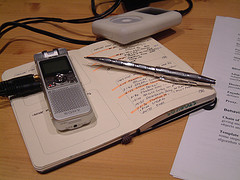@newsfromtengrrl for 2010-08-19
August 19, 2010
- 'Choose Your Own Adventure' Gets An iMakeover : NPR http://n.pr/a93GQc #
- Use Multiple Google Calendars to Balance Your College Life | Lifehacker » http://bit.ly/bYr1Sg #
- Edwin Morgan, Scotland's national poet, dies aged 90 | guardian.co.uk http://bit.ly/cy222d #
- Scottish national poet Morgan dies | AFP » http://bit.ly/dsA3az #
- Teacher Loses Job After Commenting About Students, Parents on Facebook – ABC News http://bit.ly/dj6u7V #
- A Student Reviews a Smartpen, the Livescribe Echo – NYTimes.com http://nyti.ms/9RXP8X #
- Checklist for an Open CourseWare Semester – ProfHacker – The Chronicle of Higher Education http://bit.ly/buCWzY #
- Announcing CourseBoss: Easy Assignment Management for Professors – HackCollege – http://bit.ly/cNDS8Z #
- An Open Letter to New Graduate Students – ProfHacker – The Chronicle of Higher Education http://bit.ly/bJsMy2 #
- Hidden Impact of Technology on our Everyday Lives – THE DAILY RIFF – http://bit.ly/cv2vru #
- Managing Twitter Favorites – ProfHacker – The Chronicle of Higher Education http://bit.ly/bbsj0Y #
- Teaching ‘The Grapes of Wrath’ With The New York Times – The Learning Network Blog – NYTimes.com http://nyti.ms/brDTyh #
- What Are Kidwatching, Microblogging, and Podcasts? | pedablogical @ tengrrl.com » http://bit.ly/9kHiPu #
- Williston State, in North Dakota, Gives iPads to Its Full-Time Professors – The Chronicle of Higher Education http://bit.ly/dzZMb5 #
- The Beloit College 'Mindset' List – Digital Tweed – Inside Higher Ed http://bit.ly/cpRUJZ #
- Can You Hear Me Now? – Inside Higher Ed http://bit.ly/dxk5Lw #
- Facebook Tabs: What They Are & How to Use Them | Lifehacker » http://bit.ly/95KiJD #
- How to Disable Facebook Places | Lifehacker » http://bit.ly/csRqJ5 #
- The History of the Internet, Visualized | Gizmodo » http://gizmo.do/9TQo8M #
- Active Facebook Users More Likely to Stick With College | Wired.com http://bit.ly/czPQ8I #
- Facebook Unveils Service to Announce Locations – NYTimes.com http://nyti.ms/9igzDa #
- When Life Lived Online Is Sanitized, Do We Lose Something? – NYTimes.com http://nyti.ms/a7uPAk #
- 4 Tools for Teaching Kids to Code | ReadWriteWeb http://bit.ly/9PQkKY #
- DIY Ultimate Note-Taking Notebook | Lifehacker http://bit.ly/doOAi5 #
- Where to Get the Best Free Education Online | Lifehacker http://bit.ly/b3D2q1 #
- Quick Access to Poetry in the Age of Technology – NYTimes.com http://nyti.ms/cI2cfz #
- The Freshman Foul: Poor ACT Scores – CBS Evening News – http://bit.ly/aBxgJA #
- Kids These Days: Woefully Unprepared For College – TIME » http://bit.ly/a3DNXu #
- Kids, Solid Foods, & Allergies: An Analogy for New Tech in the Classroom? – ProfHacker – Chronicle of Higher Education http://bit.ly/c3yuhM #
- Why Johnny’s College Isn’t What It Used to Be – ‘Higher Education?’ by Hacker and Dreifus – NYTimes.com http://nyti.ms/b9Li5t #
- The College Completion Agenda | College Board » http://bit.ly/c3tucZ #
Powered by Twitter Tools



 Microwave peas and carrots according to package directions.
Microwave peas and carrots according to package directions.